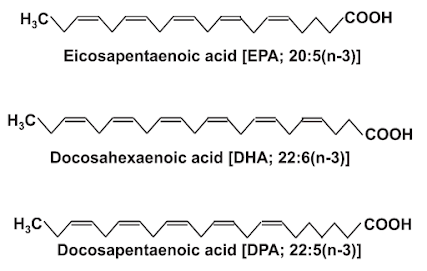α-linolenic acid (ALA) is the major n-3 fatty acid. α-linolenic acid cannot be synthesized in humans and is an essential dietary fatty acid. In the body, α-linolenic acid is metabolized to eicosapentaenoic acid (EPA) and docosahexaenoic acid (DHA).
Linseeds (flaxseeds) and their oil typically contain 45–55% of fatty acids as a-linolenic acid, whereas soybean oil, rapeseed oil, and walnuts all typically contain ~10% of fatty acids as a-linolenic acid.
The omega-3 (n-3) fatty acids, eicosapentaenoic acid (EPA; 20:5 n-3) and docosahexaenoic acid (DHA; 22:6 n-3), are found in seafood (especially fatty fish), supplements and concentrated pharmaceutical preparations.
The blubber and tissues of sea mammals, such as whales and seals, also contain EPA and DHA in significant amounts.
In addition to providing people with high-quality proteins, fish consumption satisfies nutritional requirements for essential n-3 fatty acids, primarily eicosapentaenoic (EPA; 20:5 n-3) and docosahexaenoic (DHA; 22:6 n-3) acids, which are two long chain polyunsaturated fatty acids (LC-PUFAs) mainly present in fish.
Docosapentaenoic acid (DPA) (22:5n-3), a long-chain n-3 PUFA metabolite of EPA, is also present in smaller amounts in fish.
Fish oil is obtained from oily fish flesh or lean fish livers (e.g., cod liver). Fish oil is rich in very long-chain (n-3) fatty acids and in a typical fish oil, EPA and DHA comprise ;30% of the fatty acids present.
EPA and DHA are essential for proper fetal development and healthy aging. EPA emerging as a new potential agent in the treatment of depression. EPA can reduce symptoms of depression and help fight inflammation in human body.
DHA is essential for normal fetal brain and cognitive development as the formation of neuron synapses in the brain depends strongly on the integration of this fatty acid into growing neurons. DHA is a key component of all cell membranes and is found in abundance in the brain and retina.
Increasing n-3 fatty acids intake significantly reduces the incidence of cardiovascular disease. They reduce total cholesterol, and thus minimize significantly the risk of myocardial infarction.
The potential for EPA and DHA to have a role in reducing the risk of cardiovascular disease was first identified by studies in the Greenland Inuit, where the low rate of mortality from myocardial infarction and ischaemic heart disease.
N-3 Fatty acids: DHA and EPA







